No crops were cultivated in most of the country during this monitoring period, except for some minor winter crops planted in the southern regions. Crop production in Kazakhstan is mostly rainfed, as only 3% of the cropland is under irrigation. According to the NDVI profiles, the national average NDVI values were lower than 0.2 starting from late October because of fallow or freezing conditions.
Compared to the 15-year average, accumulated precipitation was above average (RAIN +4%), while temperature and radiation were close to average. The dekadal precipitation was above the 15-year average from late October to late November and exceeded the 15-year maximum in early January. The dekadal temperature fluctuated along the average level except for the period of late November, early and late December. The agro-climatic conditions resulted in a normal potential biomass (BIOMSS +1%).
Overall, agro-climate conditions were favorable in the monitoring period. Favorable precipitation will create good conditions for the planting of spring wheat.
Regional analysis
Based on cropping systems, climatic zones and topographic conditions, four sub-national agro-ecological regions can be distinguished for Kazakhstan, among which three are relevant for crop cultivation: the Northern region (112), the Eastern plateau and southeastern region (111) and the South region (110).
In the Northern region, the accumulated precipitation (RAIN +8%) and temperature (TEMP +0.4°C) were above average, while RADPAR was average. The favorable weather conditions resulted in an increase of the BIOMSS index by 4%.
In the Eastern plateau and southeastern region, the accumulated precipitation and radiation were close to average, while the temperature (TEMP -0.9°C) was below average. The potential biomass decreased by 4% (BIOMSS, -4%).
The South region received 131 mm of rainfall, which was the lowest amount among the three regions. Due to the deficit of precipitation and lower temperature (RAIN -6%, TEMP -0.8°C), the potential biomass decreased by 9%. The agro-climate conditions were not slightly unfavorable in the monitoring period.
Figure 3.24 Kazakhstan's crop condition, October 2022 - January 2023

(a). Phenology of major crops
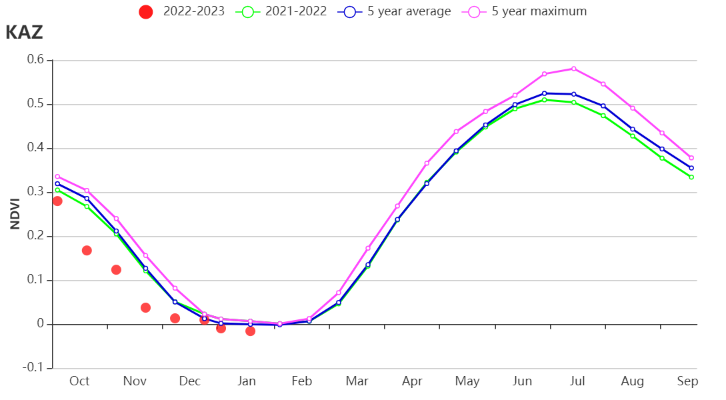
(b). Crop condition development graph based on NDVI
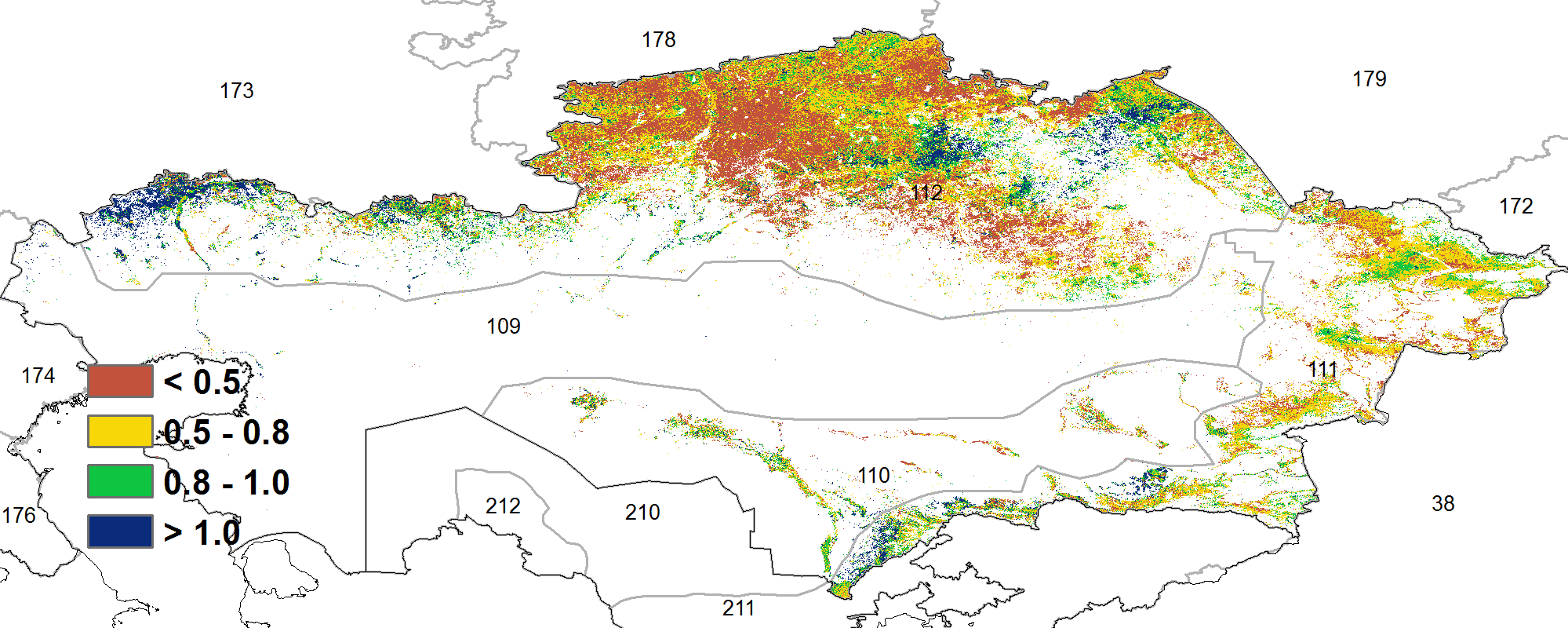
(c). Maximum VCI
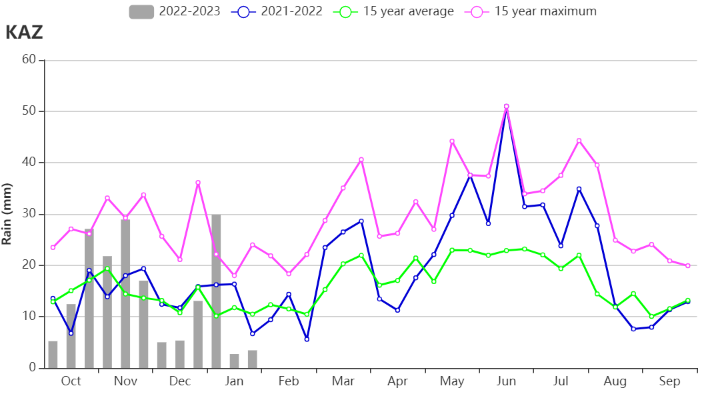
(d). Rainfall profiles
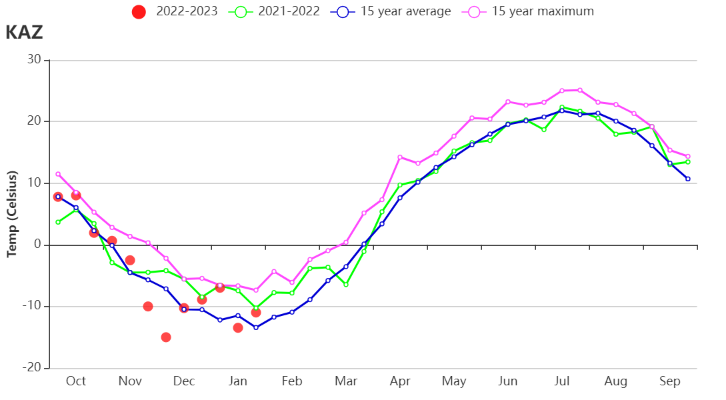
(e). Temperature profiles

(f) Spatial NDVI patterns compared to 5YA (g) NDVI profiles
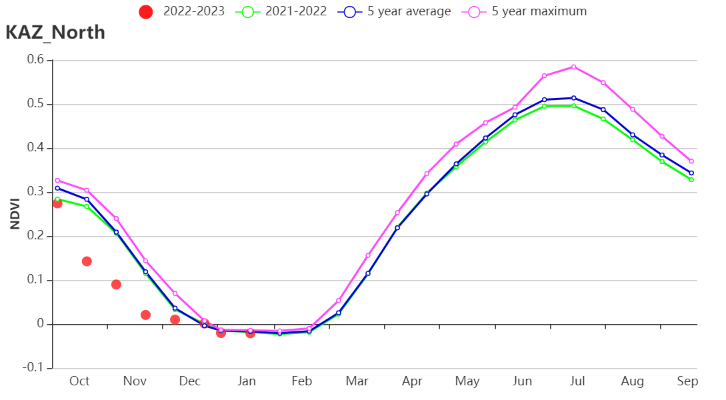
(h) Crop condition development graph based on NDVI (North region)
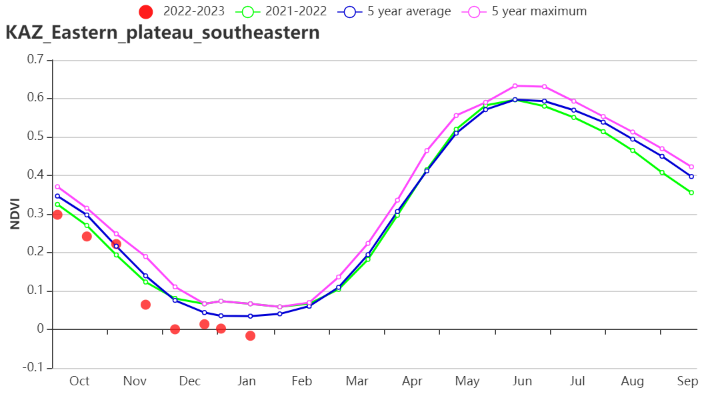
(i) Crop condition development graph based on NDVI (Eastern plateau and southeastern region)

(j) Crop condition development graph based on NDVI (South zone)
Table 3.40 Kazakhstan agroclimatic indicators by sub-national regions, current season’s values and departure from 15YA, October 2022 - January 2023
| Region | RAIN | TEMP | RADPAR | BIOMSS | ||||
| Current (mm) | Departure (%) | Current (°C) | Departure (°C) | Current (MJ/m2) | Departure (%) | Current (gDM/m2) | Departure (%) | |
| Northern zone | 157 | 8 | -5.7 | 0.4 | 284 | -1 | 251 | 4 |
| Eastern plateau and southeastern zone | 217 | 0 | -4.5 | -0.9 | 471 | 1 | 246 | -4 |
| South zone | 131 | -6 | 0.7 | -0.8 | 500 | 2 | 286 | -9 |
Table 3.41 Kazakhstan, agronomic indicators by sub-national regions, current season’s values and departure from 5YA, October 2022 - January 2023
| Region | Cropped arable land fraction | Maximum VCI | |
| Current(%) | Departure (%) | Current | |
| Northern zone | 5 | -51 | 0.63 |
| Eastern plateau and southeastern zone | 10 | -46 | 0.68 |
| South zone | 6 | -11 | 0.70 |
